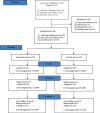Impact of Motivational Enhanced Adherence Counseling and Point-of-Care Viral Load Monitoring on Viral Load Outcome in Women on Life-Long ART: A Randomized Pilot Study
- PMID: 36105074
- PMCID: PMC9467808
- DOI: 10.1155/2022/4887202
Impact of Motivational Enhanced Adherence Counseling and Point-of-Care Viral Load Monitoring on Viral Load Outcome in Women on Life-Long ART: A Randomized Pilot Study
Abstract
We piloted the combined effectiveness of point-of-care viral load monitoring plus motivational enhanced adherence counseling (intervention) compared with routine care (control) in women identified at risk of virologic failure in the PROMOTE study in Zimbabwe. In an unblinded randomized study, consenting women with last viral load ≥200 copies/ml and/or pill count outside 90-110% range were randomized 1 : 1 to receive the intervention or continue routine care, comprising laboratory-based VL monitoring and standard EAC, from trained nurses and counsellors. Viral load was measured 0, 3, 6, and 12 months after enrolment. We compared viral suppression <200 copies/ml at 6 and 12 months between the arms through Fisher's exact test and sought associated factors by logistic regression with a 95% confidence interval (CI). Between December 2018 and July 2019, 50 women were enrolled (25 intervention and 25 controls) and followed until November 2020. At entry, 60% of the women were virally suppressed, 52% intervention vs. 68% control arm. Viral suppression was balanced between the two arms (p value = 0.248). At month 6 post study entry (primary endpont), 64% of the women retained in care were virally suppressed, 54% intervention vs. 76% control arm (p value = 0.124). At month12 post study entry (secondary endpoint), 69% of the women retained in care were virally suppressed, 67% intervention vs. 71% control arm women (p value = 0.739). More intervention women completed all scheduled sessions by month 6. Control group women were more likely to be virally suppressed at both timepoints. Only 25% had treatment switch by 12 months. Despite intense adherence support and viral load monitoring, sustained viral suppression remained elusive in women identified at risk of viral failure. These findings highlight the continued need for effective adherence intervention for women with unsuppressed HIV viral loads, efficient treatment switch strategies, as well as drug level monitoring.
Copyright © 2022 Mercy T. Mutambanengwe-Jacob et al.
Conflict of interest statement
The authors declare that there is no conflicts of interest regarding the publication of this paper.
Figures
References
-
- Matthews L. T., Orrell C., Bwana M. B., et al. Adherence to HIV antiretroviral therapy among pregnant and postpartum women during the Option B+ era: 12-month cohort study in urban South Africa and rural Uganda. Journal of the International AIDS Society . 2020;23(8) doi: 10.1002/jia2.25586.e25586 - DOI - PMC - PubMed
-
- Erlwanger A. S., Joseph J., Gotora T., et al. Patterns of HIV care clinic attendance and adherence to antiretroviral therapy among pregnant and breastfeeding women living with HIV in the context of option b+ in Zimbabwe. JAIDS Journal of Acquired Immune Deficiency Syndromes . 2017;75(2):S198–S206. doi: 10.1097/qai.0000000000001347. - DOI - PubMed
Grants and funding
LinkOut - more resources
Full Text Sources



